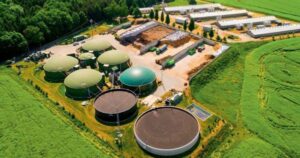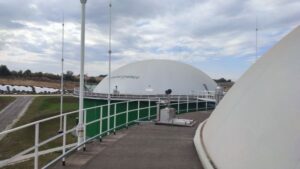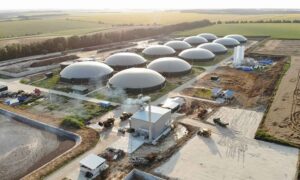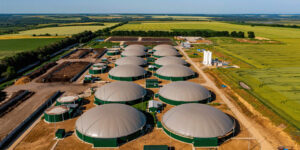
On Tuesday, June 24, Horodyshche-Pustovarivska Agrarian Company LLC (GOPAK), a member of the Hals Agro agricultural holding, exported biomethane of its own production for the first time, the industry publication ExPro reported.
According to the publication, the company exported almost 73,000 cubic meters of biomethane stored in Ukrainian underground storage facilities via the gas transportation system through Hungary. The buyer was German Uniper.
Thus, Hals Agro became the third exporter of biomethane, joining VitAgro and MHP.
“Hals Agro is a Ukrainian holding company specializing in grain and sugar production, turkey farming, and meat production. It also produces electricity from renewable energy sources and has four biogas complexes in
Kyiv and Chernihiv regions. The total design capacity is 14.7 MW of green electricity generation.
“Since 2021, Hals Agro has launched two biomethane projects, and in 2023 launched the production of the first industrial biomethane at the Lynovytske Biogas Complex.
Ashroholding has a biomethane plant in Chernihiv region with a capacity of 3 million cubic meters per year. In November 2024, it started pumping biomethane into Ukrainian underground gas storage facilities.

The Vitagro group of companies, which already has one biomethane plant with an annual capacity of 3 million cubic meters in the Khmelnytskyi region, intends to build two or three more such plants in a year and a half, each costing EUR6-6.5 million, according to the company’s director of development and investment, Serhii Savchuk.
“We plan to build two or three more plants with a capacity of 3 million cubic meters each. We estimate the cost of one plant at EUR 6-6.5 million. We will need about 1.5 years to do this,” Savchuk said in a comment to EnergoReform on the sidelines of the Solar Agro Conference organized by the Solar Energy Association of Ukraine.
He did not specify the details of biomethane exports from the first plant, noting that after a test delivery in February, “everything the plant produces is sold to a number of countries, including Germany and the UK, at market prices.”
During his speech at the conference, he suggested that the company may work with Ukrainian banks to expand its biomethane capacity.
“Today, our plant with a capacity of 3 million cubic meters of biomethane, which is produced from manure from our livestock complexes, is fully operational. We will build a pipeline, Ukrgasbank is here, you can pay attention to us,” he said to conference participant Mykola Alferov, deputy director of the SME Department at UGB.
Savchuk also noted that during the war, the group launched a bioethanol plant in the Ternopil region by reconstructing an alcohol plant it privatized at the end of 2022, which cost EUR20 million.
“We invested EUR 20 million, completely re-equipped the distillery, and now have 25,000 tons of bioethanol for export from the processing of 85,000 tons of corn,” explained the director of development and investment at Vitagro.
In a comment to Energorforma, Savchuk expressed hope that cooperation will eventually be established for the sale of bioethanol to fuel companies in Ukraine, which from May 1 must sell gasoline containing at least 5% of this substance, but do not mix the product here, instead importing it ready-made from Europe.
He also shared his experience of installing SES groups on farms for their own consumption, which he called “an absolutely effective investment.”
“Seven solar stations for our own consumption were installed in a few months, and we have developed an appetite for a second phase, so we want to launch separate complexes both on the roof and on the side. This is economics, this is ecology, this is the ESG (Environmental, Social, and Governance) trend, which is very relevant. We are a good example for the development of SES for our own consumption, and in the future there will be energy storage,” Savchuk said about Vitagro’s plans.
As reported in February 2025, Vitagro announced its intention to reach the planned annual capacity of the biomethane plant of 3 million cubic meters in 2025 and, if exports are successful, to build two more plants (in the Khmelnytskyi and Rivne regions) to increase production and exports.
At that time, it was indicated that the group of companies was considering the option of attracting foreign investors to its capital.
The company expected that the EUR6 million invested in the construction of the first biomethane plant in the Khmelnytskyi region would pay off in five years, but if the market continued to grow, it would pay off sooner. The company’s cost price for biomethane was stated at over EUR 500 per 1,000 cubic meters.
In February, the chairman of the board of the Bioenergy Association of Ukraine, Georgy Geletukha, noted that the average price of biomethane for export to Europe could be approximately EUR 900 per thousand cubic meters.
Agroholding Vitagro exported its first batch of biomethane in 67,000 cubic meters (destination country – Germany) on February 6, 2025.
The Vitagro group of companies is engaged in the production and processing of agricultural crops, in particular fruits and vegetables, dairy farming, and pig breeding. The group cultivates about 85,000 hectares of land in the Khmelnytskyi, Ternopil, and Rivne regions. In 2022, it acquired the Marylivsky Distillery (Nagirnyanka village, Ternopil region) from Ukrspirt.
According to the Unified State Register of Legal Entities and Individual Entrepreneurs, the ultimate beneficiary of the investment company Vitagro is People’s Deputy Serhiy Labazuk (parliamentary faction “For the Future”).

In 2030, Ukrainian biomethane producers will be able to supply up to 1 billion cubic meters of this fuel to the EU, says Maciej Zaniewicz, Green Deal Ukraine project expert, senior analyst at Forum Energii (Poland), who is a co-author of the study “Potential for Cooperation between Ukraine and the EU in the Field of Biomethane” by Green Deal Ukraine and the Ukrainian Climate Office.
“In our opinion, as well as in the opinion of Ukrainian analysts, the real volumes of biomethane production in Ukraine can be plus or minus 0.5% of EU demand. We are talking about about 1 billion cubic meters of biomethane in 2030,” Zanevych said in an interview with theInterfax-Ukraine energy project Energoreforma.
According to him, the most interesting thing in the study on the potential for cooperation in this area was that Ukrainian biomethane has already found buyers at market prices in the EU.
“At the same time, demand in the EU is so high that Ukrainian imports will not hinder the development of the industry within the EU,” the expert believes.
At the same time, he notes that Ukrainian biomethane “will not become some kind of export hit for Ukraine and a panacea for the EU.”
“What I mean is that it will not fully replace natural gas imports to the EU. Yes, it is an important component for diversifying gas supplies, but it will not completely replace imports,” Zanevych explained.
He also drew attention to the risk that pro-Russian circles will try to sow disinformation, “as it was with the trucks, as it was with the farmers.” “That allegedly Ukrainian biomethane producers will displace European producers. That’s why we wanted to make a reliable analysis based on objective data and show how it can actually be,” the expert said.
As reported, the first batch of Ukrainian biomethane of 67 thousand cubic meters was exported on February 7, 2025 by Vitagro, an energy holding whose plant with a capacity of 3 million cubic meters of biomethane per year operates in Khmelnytsky region. The exports were made to Germany.
On February 11, MHP’s biomethane plant Oril-Leader (Dnipropetrovs’k region) exported 27.4 thousand cubic meters of biomethane and became the second Ukrainian company to do so. MHP exported biomethane via gas pipelines across the Ukrainian-Polish border to Germany. The buyer was Vitol. The capacity of Oril-Leader is 11 million cubic meters per year.
The Gals Agro agricultural holding has built a biomethane plant with a capacity of 3 million cubic meters in Chernihiv region. The company has already been connected to the grid and is preparing to export its products.
At the Ukrainian Investment Congress in Kyiv in early March, Georgii Geletukha, Chairman of the Board of the Bioenergy Association of Ukraine (BAU), said that Ukraine could soon become the main supplier of biomethane to the European Union, with the share of Ukrainian products in the European market reaching 20% in the future.
Geletukha emphasized that Europe aims to consume approximately 35 billion cubic meters of biomethane in 2030, while European production is currently estimated at 3 billion cubic meters. Given the current market trends, the EU will be able to increase its own production to 20 billion cubic meters of biomethane within five years.
The expert explained such a delay in the development of the biomethane market in Europe by the lack of large free areas of agricultural land and, accordingly, the inability to produce the necessary amount of raw materials for processing.
He drew attention to Europe’s new plans for 2030, which include the production and consumption of 100 billion cubic meters of biomethane by 2050. However, it will not reach this figure because of the lack of raw materials, the expert believes.
According to his assumption, if Ukraine were to produce up to 15 billion cubic meters of biomethane now, the EU would “buy everything with a bang.”
According to him, in Ukraine, the range of biomethane producers and potential exporters will expand in 2025. They will be joined by another MHP company, Teofipol Energy Company, and Józefów-Mykolaiv Biogas Company. In total, Ukrainian facilities will produce 111 million cubic meters of biomethane per year.
At a cost of EUR900 per 1 thousand cubic meters of biomethane produced from crop waste or from animal waste, including manure or litter, at EUR1100-1200 per 1 thousand cubic meters, Ukraine will be able to receive up to EUR100 billion annually from exporting these products to the EU, Geletukha predicts.
The study on the prospects of cooperation between Ukraine and the EU in the field of biomethane is available at https://greendealukraina.org/uk/products/analytical-reports/the-potential-of-ukraine-eu-biomethane-cooperation

Ukraine may soon become the main supplier of biomethane to the European Union, with the share of Ukrainian biomethane in the European market reaching 20% in the future, said Georgiy Geletukha, Chairman of the Board of the Bioenergy Association of Ukraine (BAU).
“Ukraine has almost ideal conditions for biomethane production. We have medium and large agricultural enterprises with 3 thousand hectares of land (under cultivation – IF-U). We can get raw materials for the plant from a single source. We have a well-developed gas structure: distribution networks and a gas transmission network. We have the highest density of gas network coverage in the whole of Europe. We have the largest area of agricultural land and, accordingly, the largest resource. Therefore, this is a very promising topic for us,” he said at the Ukrainian Investment Congress in Kyiv.
Heletukha emphasized that Europe has ambitious plans for the production and consumption of biomethane and aims to consume about 35 billion cubic meters in 2030. At present, European production is estimated at around 3 billion cubic meters. Given the current trends in the alternative energy market, the EU will be able to increase its own production to 20 billion cubic meters of biomethane within five years.
The expert explained this delay in the development of the biomethane market in Europe by the lack of large free areas of agricultural land and, accordingly, the inability to produce the necessary amount of raw materials for processing.
“And according to all trends, it will not have time to produce 35 billion cubic meters. Well, according to the trends over the past five years, they will reach about 20 billion cubic meters. The market there (in the EU – IF-U) is completely different for agricultural products. It is deficit. And it will be deficient at least until 2050. And after 2030, Europe is setting new plans – production and consumption of 100 billion cubic meters of biomethane by 2050. It will be the same story. That is, they do not have time, they do not have enough raw materials,” Geletukha emphasized.
He suggested that if Ukraine were to produce up to 15 billion cubic meters of biomethane now, the EU would “buy everything with a bang.”
The UABIO CEO reminded that three powerful producers – MHP, Vitagro and Gals Agro – have already launched biomethane production in Ukraine, of which two have already started exporting, and the third is accumulating stocks in storage and will start exporting in the near future.
According to him, in Ukraine, the range of biomethane producers and potential exporters will expand in 2025. They will be joined by another MHP enterprise, Teofipol Energy Company and Józefów-Mykolaiv Biogas Company. In total, Ukrainian facilities will produce 111 million cubic meters of biomethane per year.
At a cost of EUR900 per 1 thousand cubic meters of biomethane produced from crop waste or from livestock waste, including manure or litter, at EUR1100-1200 per 1 thousand cubic meters, Ukraine will be able to receive up to EUR100 billion a year from exporting these products to the EU, Geletukha predicts.
As reported, the first batch of Ukrainian biomethane of 67 thousand cubic meters was exported on February 7, 2025 by Vitagro, an energy holding whose plant with a capacity of 3 million cubic meters of biomethane per year operates in Khmelnytsky region. The exports were made to Germany.
On February 11, MHP’s biomethane plant Oril-Leader (Dnipropetrovska oblast) exported 27.4 thousand cubic meters of biomethane, becoming the second Ukrainian company to do so. MHP exported biomethane via gas pipelines across the Ukrainian-Polish border to Germany. The buyer was Vitol. The capacity of Oril-Leader is 11 million cubic meters per year.
The Gals Agro agricultural holding has built a biomethane plant with a capacity of 3 million cubic meters in Chernihiv region. The company has already been connected to the grid and is preparing to make its first biomethane export transaction.

President of Ukraine Volodymyr Zelensky has signed a law on the development of biomethane production in Ukraine (No. 5464), which was adopted by the Verkhovna Rada at the second reading on October 21. The corresponding note appeared on the page of the bill on the parliament’s website on Tuesday.According to the press service of the State Agency for Energy Efficiency and Energy Saving of Ukraine, this law lays the foundation for the production and development of biomethane in Ukraine, as well as its export to the countries of the European Union.It is specified that for this purpose it is planned to introduce the appropriate terminology, the possibility of verifying purified biogas (biomethane), the physical and chemical characteristics of which must meet the requirements of regulatory legal acts for natural gas, issuing a guarantee of origin for the volume of biomethane produced, entering a register of production and consumption of biomethane.“Development of a register of production and use of biomethane and cooperation with similar registers of EU countries is a potential opportunity to sell biomethane to other countries, confirmed by a guarantee of origin,” the message reads.It notes that, in pursuance of the State Energy Efficiency Law, work has already begun on the development of a procedure for the functioning of the biomethane register.As reported, bill No. 5464 adopted by the Verkhovna Rada regulates the concept of “biomethane” as “biogas,” which in its physical and technical characteristics corresponds to the regulatory legal acts on natural gas for supply to gas distribution and transmission networks or for use as a motor fuel.In addition, the document provides for the creation of a biomethane register for accounting in the system, establishes the procedure for the formation of guarantees of origin of biomethane.According to the Bioenergy Association of Ukraine, the potential for biomethane production in Ukraine is 8 billion cubic meters annually, which corresponds to 25% of domestic gas consumption.According to Minister of Agrarian Policy and Food Roman Leschenko, the development of biomethane production gives Ukraine every chance to become a center for its production and supply, as well as a source of energy security for Europe. Its use in production chains will allow Ukrainian farmers to obtain an alternative source of energy from waste and secondary products of their own production and, as a result, to use biomethane instead of natural gas for generating heat and electricity, as well as to use it as a fuel for transport and as a raw material for the chemical industry.

The sale of agricultural products and residues of its production for the operation of biogas plants can become a guarantor of the state’s energy security, the agricultural sector can significantly strengthen NJSC Naftogaz Ukrainy from the point of view of energy independence. As reported on the website of the Ministry of Agrarian Policy and Food on Tuesday with reference to Minister Roman Leshchenko, the adoption at the final reading bill No. 5464 on amendments to the law of Ukraine on alternative fuels regarding the development of biomethane production by the Verkhovna Rada last week gives Ukraine every chance to become a center for the production and supply of biomethane, as well as a source of energy security for Europe.
“In the conditions of very expensive energy resources – gas and electricity, not only food security, but also energy security is impossible without the agricultural sector,” Leshchenko said.
He said that the development of the biomethane market will allow Ukrainian farmers to obtain an alternative source of energy from waste and residues of their own production, and as a result, use biomethane instead of natural gas for the production of heat and electricity, as well as fuel for transport and raw materials for the chemical industry.